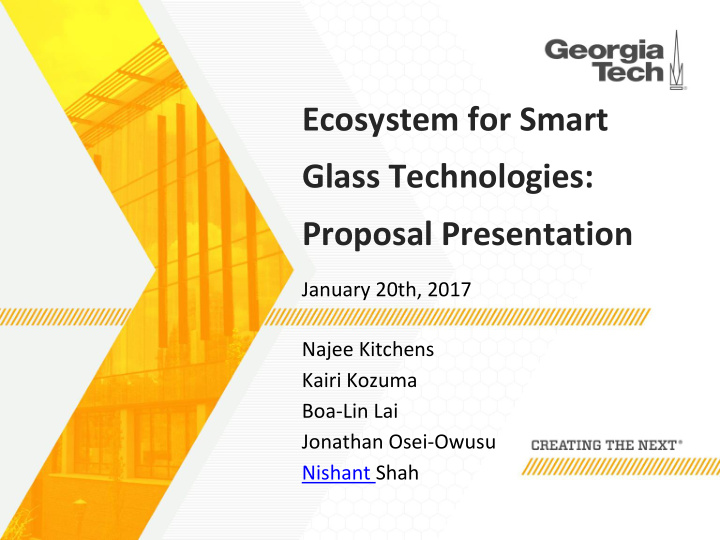



Ecosystem for Smart Glass Technologies: Proposal Presentation January 20th, 2017 Najee Kitchens Kairi Kozuma Boa-Lin Lai Jonathan Osei-Owusu Nishant Shah
Agenda • Project Description and Goals • ESGT Overview • Background Research • Cost and Budget • Smart Mirror Features • Design Approach • Projected Schedule • Status • Accomplishment • Question and Answer
Project Description and Goals • ESGT: Ecosystem for Smart Glass Technologies • Objective – Create hardware and software ecosystem for all glass IoT devices – Extensibility to add support for any glass product • Motivation – Transparent IoT devices are not widespread yet • Difficulty implementing transparent technology • No commercial products readily available to the user at an affordable price • Smart Mirror will be prototype to demonstrate ESGT
ESGT Overview Hardware Ecosystem Transparent Display Interaction Interface Technology Software Ecosystem API calls for retrieving Server Backend data Application Specific Modules
Background Research • Traditional capacitive touch • TCOs for transparent with high sensitivity circuitry Floating • Gesture recognition from Transparent Touch or • Inkjet printing for rapid images captured via Display Gesture prototyping stereoscopic sensor Technology Recognition • Wi-Fi to connect to the • Performance and power Internet tradeoff Wireless Microcontroller – Offload computation Connectivity – Powerful enough to to the cloud drive large display, • Bluetooth for but efficient to run smartphone off battery communication
Cost and Budget (Prototype 1) Table 1. Prototype 1 Equipment Costs Component Cost Raspberry Pi™ 3 Model B $35.00 Raspberry Pi™ Power $8.99 Supply Two-Way Mirror $72.00 Touchscreen LCD Monitor $289.95 HDMI Cable $0.00 (Received for free) Total $405.94
Cost and Budget (Prototype 2) Table 2. Prototype 2 Equipment Costs Component Cost Rectangular Annealed Glass $20.11 Raspberry Pi™ 3 Model B $0.00 (Reuse from Prototype 1) Raspberry Pi™ Power Supply $0.00 (Reuse from Prototype 1) Conductive Silver Ink $0.00 (Received for free) HDMI Cable $0.00 (Received for free) Inkjet Printer $0.00 (Received for free) Total $20.11
Smart Mirror Features • Display weather, agenda, news, and other relevant information • Smartphone application to set up and configure the smart mirror • Won’t obstruct user figure when smart mirror is displaying information • Appearance of a regular mirror when display is off
Design Approach (Hardware) • Translucent Display – Adhere behind mirror • User interaction – Touch Screen • Floating capacitive touch – Gesture Sensor (leap motion) • Interaction with mirror with gestures
Design Approach (Microcontroller) • Raspberry Pi 3 Model B – 4 USB ports – 40 GPIO pins – Full HDMI port – A 1.2GHz 64-bit quad- core ARMv8 CPU – 802.11n Wireless LAN – Bluetooth 4.1 – Bluetooth Low Energy (BLE) – Micro SD card slot
Design Approach (Software) • User Interface – Mirror GUI will be implemented using HTML and CSS • Flexibility and portability to different systems. – Add interactivity using javascript • Backend – Python and Ruby for computation and communication with phones and other peripherals • Module API – Allow more UI components to be added easily – UI and Backend will have a module framework with an API • Database – Local database to cache data retrieved from various sources
Design Approach (Software) • Backend code will connect and send or retrieve data from peripheral devices – Phone • Main source for personal data such as calendar and email • Sensors (GPS) can give contextual information about the user • Communication through bluetooth or Wi-Fi – Leap Motion • Additional source of direct user input through gestures • Communication will be through a direct USB connection
Projected Schedule • Simplified Gantt chart • Hardware and software development done in parallel – Use simple prototype to allow software team to get started • Work on software framework, common to all glass IoT devices – Hardware team implements transparent display technology • Shift towards software when smart mirror application development begins • Ample time for project documentation and demonstration
Status • List all the needed parts for Smart Mirror Project • Will place an order for prototype parts (week of 1/23-1/27) • Collect feedback of project ideas from advisor and survey samples
Accomplishment • Survey – Project specification • Break Off Into Teams – Hardware • Assemble parts • Configuration on I/O – Software • Backend Server (database) • UI design • Analyzing data from sensors • Module API
Question and Answer
Recommend
More recommend